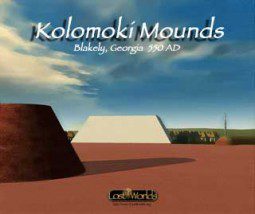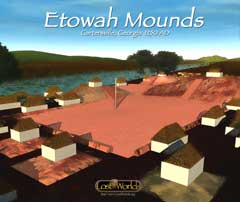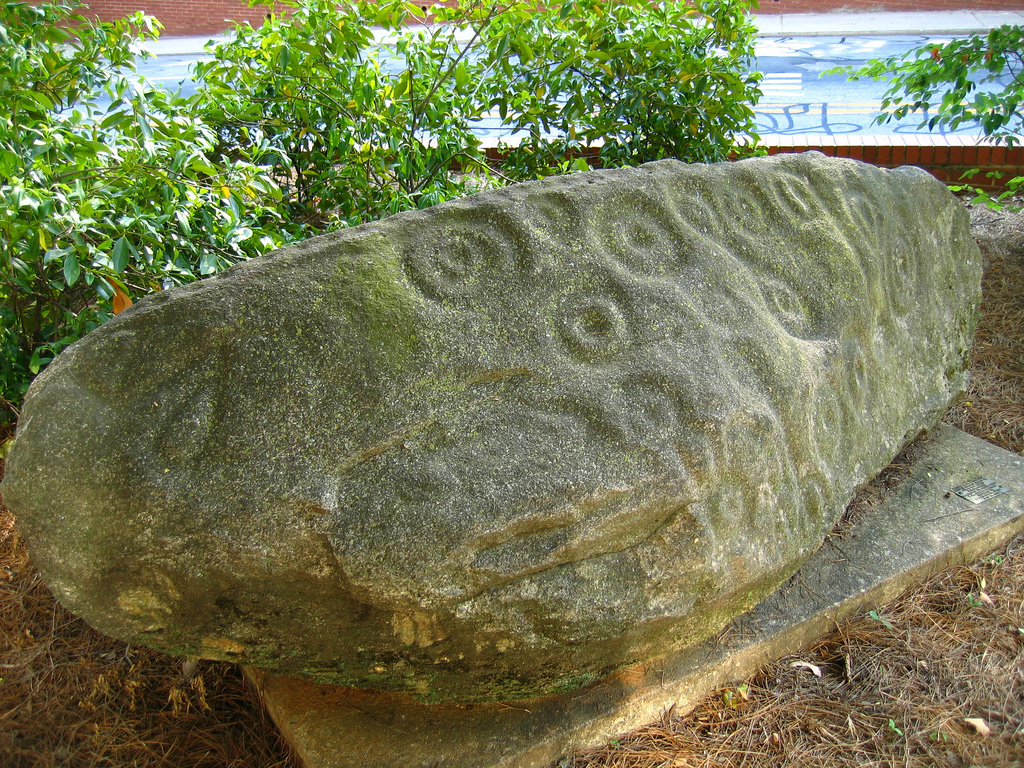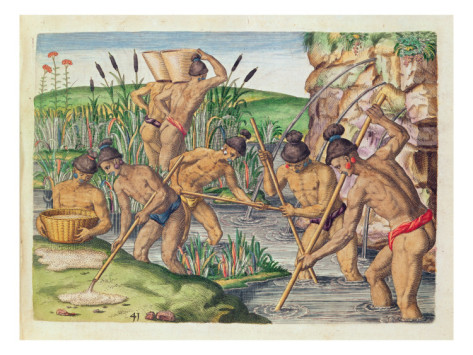Kolomoki Mounds (500 AD)
Where did the people of Kolomoki go?
An intriguing clue lies in the architecture of a house-type first identificed at Kolomoki. Known as a keyhole house, the structure had a rectangular floor recessed three feet below the surface of the ground. Steps led down into the house through a tunnel-like entrance. Coincidentally, about fifty years after Kolomoki was abandoned this same unique house-type appeared in Arkansas at a site known today as Toltec Mounds. Approximately 100 years

later this house-type appeared at the very important archaeological site known as Cahokia near modern-day St. Louis, Missouri. Did the elite families of Kolomoki migrate into Arkansas and Missouri after they left southwest Georgia?
Sometime around A.D. 675 the volcano Popocatepetl in central Mexico had one of its largest eruptions ever. The great Mexican city of Teotihuacan also went into decline around the same time. Teotihuacan was the most populous city in the New World and the sixth most populous in the entire world but by A.D. 750 both Teotihuacan and Kolomoki would be abandoned and their inhabitants would migrate to other areas. The great Teotihuacan would be burned by its own rioting inhabitants. They would also smash statues of their rain god perhaps for failing to deliver the much needed rain. Around the world a similar pattern occurred: established empires crumbled and new powers emerged. It is also interesting to note that the large mound at Kolomoki, Mound A, was at one point covered in white clay and then eventually capped with a final red clay layer. Had Kolomoki changed from a “white” peace town into a “red” war town before its decline?
The stage was now set for the arrival of a new people in Georgia who came from the west and brought with them new ideas. These people were the Mississippians and they constructed the next great site in our story: Ocmulgee Mounds.
Resources & Additional Reading:
- Pluckhahn, Thomas J. Kolomoki: Settlement, Ceremony, and Status in the Deep South, A.D. 350 to 750. Tuscaloosa, AL: University of Alabama Press, 2003.
- Pluckhahn, Thomas. “Kolomoki Mounds.” New Georgia Encyclopedia. 2002.
- Morgan, William N. Pre-Columbian Architecture in Eastern North America. Gainesville, FL: University of Florida Press, 1999.
- White, Max E. The Archaeology and History of the Georgia Native Tribes. Gainesville, FL: University of Florida Press, 2002.
- Milner, Richard Sanders. “Apalachicola.” Northwest Florida Place Names of Indian Origin. 1998.
- “Hitchiti.” Wikipedia.org. http://en.wikipedia.org/wiki/Hitchiti
- “Weeden Island culture.” Wikipedia.org. http://en.wikipedia.org/wiki/Weeden_Island_culture
- Allison, David. “Possible Astronomical Symbols on ‘Sacred’ Weeden Island Pottery.” Early Georgia. June 2003.
- “Swift Creek Culture.” Wikipedia.org. http://en.wikipedia.org/wiki/Swift_Creek_Culture
- “Miccosukee.” Wikipedia.org. http://en.wikipedia.org/wiki/Miccosukee
- “Chiaha.” Wikipedia.org. http://en.wikipedia.org/wiki/Chiaha
- Grantham, Bill. Creation Myths and Legends of the Creek Indians. University Press of Florida, 2002: p. 136.
- Boot, Erik. A Short Itza Maya Vocabulary. FAMSI. June 1995.
- Williams, Mark. Hitchiti- An Early Georgia Language. LAMAR Institute Publication 21, 1992..
- Smith, David. “Quetzalcoatl- The Plumed Serpent.” Atlanta Antiquity. Greater Atlanta Archaeological Society, September 2009.
- Smith, David. “Three Designs that Represent the Year ‘2 Cane.'” Atlanta Antiquity. Greater Atlanta Archaeological Society, July 2009.
- Morelli, Keith. “45-Foot Ancient Canoe Stuck in the Muck of Weedon Island.” The Tampa Tribune, 5 May 2008.
- “Extreme weather events of 535-536.” Wikipedia.org.
- Keys, David. Catastrophe: A Quest for the Origins of the Modern World. New York: Ballantine Books, 1999.
- Than, Ker. “Comet smashes triggered ancient famine.” New Scientist, 07 January 2009.
- Abbott, Dallas H. “Mega Tsunami of the World Oceans: Chevron Dune Formation, Micro-Ejecta, and Rapid Climate Change as the evidence of Recent Oceanic Bolide Impacts.” Geophysical Hazards. International Year of Planet Earth, 2010, Part 5, 197-227.
- Unknown, David. “Year of Darkness 535 A.D.”
- Palfrey, Dale Hoyt. “Mysteries of the Fifth Sun: the Aztec Calendar.” Mexconnect.com.
- “Tang Dynasty.” Wikipedia.org. http://en.wikipedia.org/wiki/Tang_Dynasty
- “Fred Lawrence Whipple.” Wikipedia.org. http://en.wikipedia.org/wiki/Fred_Lawrence_Whipple
- Whipple, Fred L. “Photographic meteor studies. III. The Taurid shower.” Proceedings of the American Philosophical Society, 83, 711-745, 1940.
- “Taurids.” Wikipedia.org. http://en.wikipedia.org/wiki/Taurids
- Thorton, Richard. “America’s architectural heritage: Kolomoki, the town in the middle of nowhere.” Examiner.com, 18 March 2010.




Pingback: Mayan Glyphs on Pottery in Georgia? « Machimon